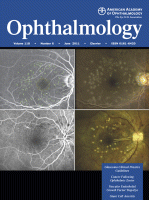Abstract
PURPOSE: To describe patient characteristics, classification, and onset of prethreshold retinopathy of prematurity (ROP), and ocular findings at 6 months corrected age in infants with birth weights <500 g who were enrolled in the Early Treatment for Retinopathy of Prematurity (ETROP) Study.
DESIGN: Multicenter randomized clinical trial.
PARTICIPANTS: Sixty-three infants with birth weights <500 g who developed ROP and were enrolled in the ETROP Study.
METHODS: Infants <1251 g at birth were logged at 26 study centers from October 1, 2000, to September 30, 2002, and underwent examinations for ROP. Infants who developed ROP and whose parents/legal guardians consented were enrolled in the ETROP Study. Infants who developed high-risk prethreshold ROP were randomized; 1 eye was treated early with peripheral retinal ablation and the other eye was managed conventionally, or, in asymmetric cases, the high-risk eye was randomized to early peripheral retinal ablation or conventional management. All eyes reaching prethreshold ROP were examined when infants reached 6 months corrected age.
MAIN OUTCOME MEASURES: Retinopathy of prematurity incidence, characteristics, and ocular findings among participants.
RESULTS: Thirty-four infants reached prethreshold or worse severity in 1 or both eyes. Retinopathy of prematurity was located in zone I in 43.3% of all prethreshold eyes, and plus disease was present in 46.7%. Median postmenstrual age for diagnosis of all prethreshold ROP was 36.1 weeks, but earlier (35.1 weeks) for eyes that developed high-risk prethreshold ROP. In the 27 surviving infants with prethreshold ROP, ophthalmic examination at 6 months corrected age showed a normal posterior pole in 22 (81.5%), a favorable structural outcome with posterior pole abnormalities in 4 (14.8%), and an unfavorable structural outcome (stage 4B) in 1 (3.7%). One infant developed amblyopia, 4 infants developed nystagmus, 4 infants developed strabismus, and 8 infants developed myopia >-5.00 diopters.
CONCLUSIONS: This is the first report on characteristics of prethreshold ROP in infants with birth weights <500 g. These infants are at high risk for developing prethreshold ROP, although many initially achieve a favorable structural outcome. They are at risk of developing strabismus, nystagmus, high myopia, and abnormal retinal structure and should therefore receive continued long-term follow-up.
FINANCIAL DISCLOSURE(S): The author(s) have no proprietary or commercial interest in any materials discussed in this article.
Free PMC article. PMCID: PMC4381929

